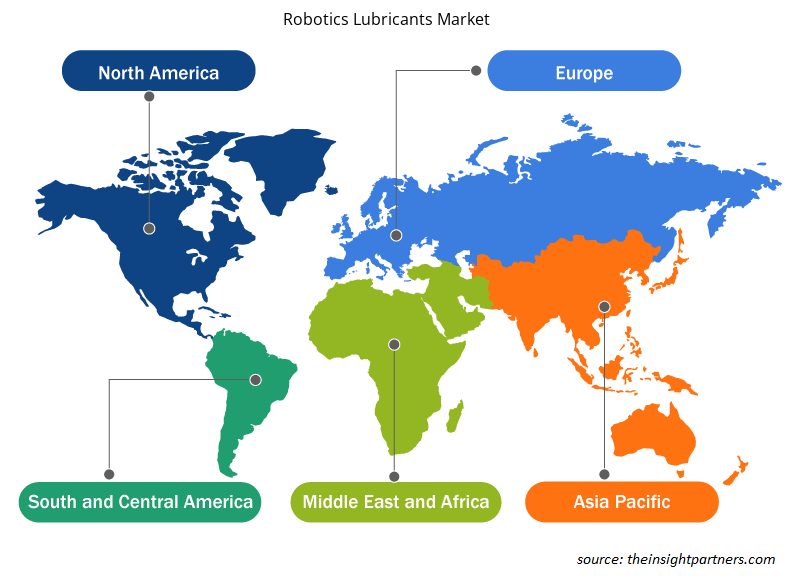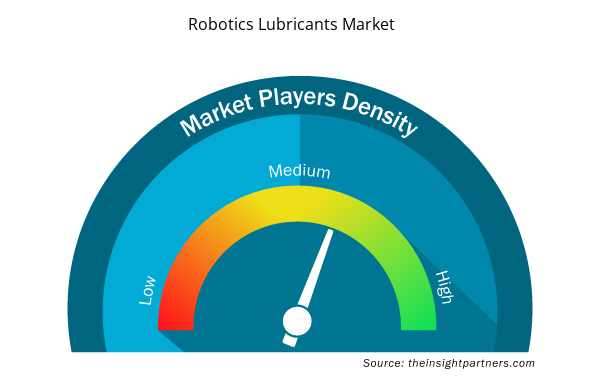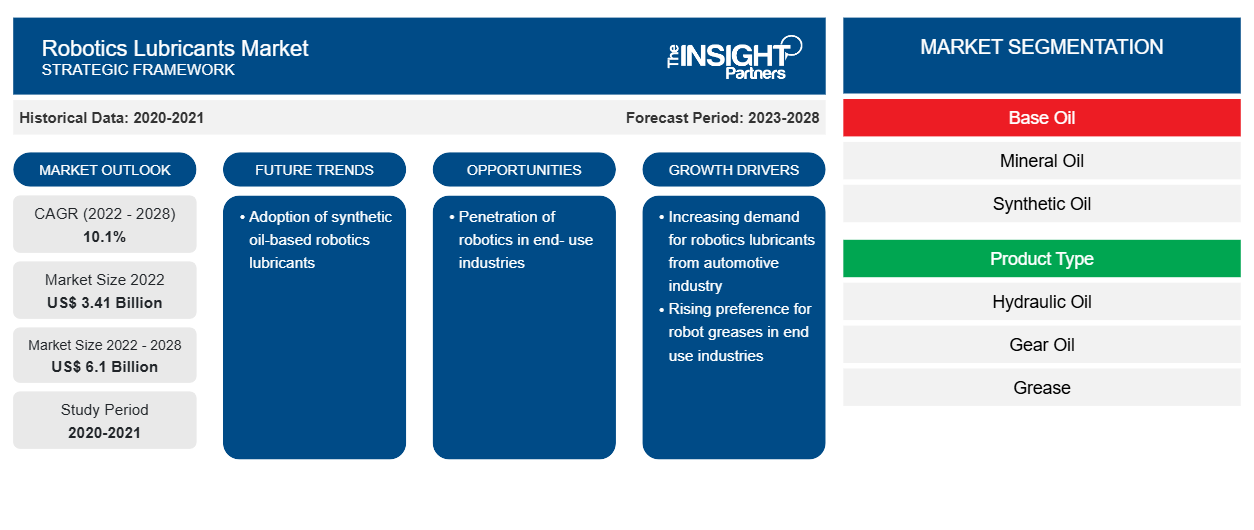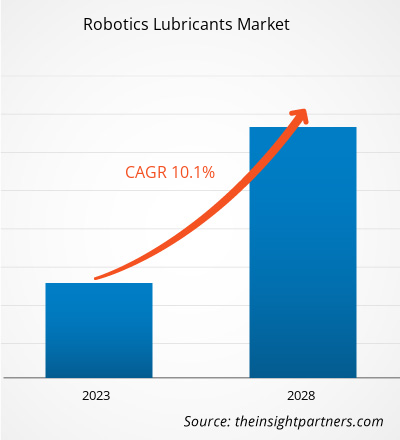[調査レポート] ロボット潤滑油市場規模は、2022年の34億1,372万米ドルから2028年には60億9,541万米ドルに成長すると予想されており、2022年から2028年にかけて10.1%のCAGRを記録すると予測されています。
市場分析
潤滑剤は、表面間の摩擦と発生する熱を減らし、関連する表面の寿命を延ばすために使用されます。産業用ロボットは、材料の取り扱い、組み立て、分配に関与しているため、摩耗や腐食の影響を受けます。ロボット用の潤滑剤は、産業用ロボットのダウンタイムを減らし、製造プロセスの品質、コスト、効率にプラスの影響を与えるために開発されています。潤滑剤は、過酷な条件に耐えるさまざまな液体で構成されています。グリースは、ロボット操作に広く使用されている潤滑剤です。
成長の原動力と課題
最終用途産業におけるロボット潤滑油の需要の高まりは、ロボット潤滑油市場の成長を後押ししています。製造業では、ロボット潤滑油は、機器が最大限の信頼性と最高の効率で動作するための重要なコンポーネントの 1 つです。グリース、油圧オイル、ギアオイルは、自動車、電気および電子、食品および飲料、物流、金属および機械加工など、さまざまな最終用途産業で使用されています。ロボットグリースには、鉱油や合成油などのベースオイル、増粘剤、添加剤が含まれており、独特の製品品質を付与します。グリースは、密封性、低漏れ傾向、腐食防止、高荷重処理など、いくつかの特性を備えています。市販されているロボットグリースのいくつかは食品グレードであり、食品および飲料、医療およびヘルスケアなどの特定の産業向けの特定の国際規格に準拠しています。グリースは、摩擦や極端な温度への暴露により劣化し、粘度レベルが不十分になり、内部の機械部品を効果的に潤滑できなくなります。ロボットのグリースは、ロボットとロボット部品の全体的な効率を維持する上で不可欠な部分です。ロボットの給脂の推奨頻度は、ブランドやモデルによって異なります。したがって、グリースが他の潤滑剤よりも優れていることと、最終用途産業からのロボットグリースの好みが、ロボット潤滑剤市場を牽引しています。しかし、世界的な経済状況の変動により、添加剤、ベースストック、輸送、製造のコストが増加しました。いくつかのメーカーは、潤滑剤サプライチェーン全体でインフレ圧力と潤滑剤添加剤の供給を目撃しました。2022年、米国のベースオイル価格は1ガロンあたり2ドルから5ドルに上昇しました。さらに、2022年にFUCHS Lubricants Coは、2022年10月から実施された潤滑剤添加剤ポートフォリオの8〜12%の値上げを発表しました。さらに、2022年にErgon Incはナフテン系ベースオイルの価格を引き上げました。しかし、2023年にChevron Corporationはベースオイル価格を0.20ドルから0.50ドル引き下げると発表しました。したがって、原材料価格の変動がロボット潤滑油市場の成長を抑制しています。
要件に合わせてレポートをカスタマイズする
このレポートの一部、国レベルの分析、Excelデータパックなど、あらゆるレポートを無料でカスタマイズできます。また、スタートアップや大学向けのお得なオファーや割引もご利用いただけます。
- このレポートの主要な市場動向を入手してください。この無料サンプルには、市場動向から見積もりや予測に至るまでのデータ分析が含まれます。
レポートのセグメンテーションと範囲
「2028 年までの世界のロボット用潤滑油市場分析」は、世界のロボット用潤滑油市場の動向と成長機会に重点を置いた専門的で詳細な調査です。このレポートは、ベースオイル、製品タイプ、最終用途産業、および地域別の詳細な市場区分とともに、世界のロボット用潤滑油市場の概要を提供することを目的としています。世界のロボット用潤滑油市場は、最近高い成長を遂げており、予測期間中もこの傾向が続くと予想されています。このレポートでは、主要な地域と国での需要とともに、世界中のロボット用潤滑油の消費に関する主要な統計を提供します。さらに、レポートでは、主要な地域と国でのロボット用潤滑油市場のパフォーマンスに影響を与えるさまざまな要因の定性的な評価を提供します。レポートには、ロボット用潤滑油市場の主要プレーヤーとその主要な戦略的開発に関する包括的な分析も含まれています。市場ダイナミクスに関するいくつかの分析も含まれており、主要な推進要因、市場動向、および収益性の高いロボット用潤滑油市場の機会を特定するのに役立ちます。これにより、主要な収益源を特定するのに役立ちます。
さらに、エコシステム分析とポーターの 5 つの力の分析により、世界のロボット潤滑油市場の 360 度の視点が得られ、サプライ チェーン全体と市場の成長に影響を与えるさまざまな要因を理解するのに役立ちます。
セグメント分析
世界のロボット用潤滑油市場は、ベースオイル、製品タイプ、最終用途産業に基づいてセグメント化されています。ベースオイルに基づいて、ロボット用潤滑油市場は鉱油、合成油、その他に分類されています。製品タイプに基づいて、市場は油圧油、ギアオイル、グリースに分類されています。最終用途産業に基づいて、市場は自動車、食品および飲料、医療およびヘルスケア、電気および電子、金属、およびその他の製造業に分類されています。
鉱油をベースとすると、鉱油はロボット潤滑油市場で大きなシェアを占めています。多くの潤滑油メーカーは、ロボットのギア部品、チェーン、ベアリング、ねじ接続の用途向けに多目的潤滑油を提供しています。Castrol Ltd は、すべてまたは一部のロボット軸方向用途向けに、Optigear ALR 320、Optigear BM 100、Alpha SP 320 などの鉱物ベースのギアオイルを提供しています。製品タイプ別では、グリース部門が最大の市場シェアでロボット潤滑油市場をリードしています。最終用途産業別では、自動車がロボット潤滑油市場の主要なシェアを占めています。電気および電子部門は、予測期間中に最も速い CAGR を記録すると予想されています。
地域分析
このレポートは、北米、ヨーロッパ、アジア太平洋(APAC)、中東およびアフリカ(MEA)、中南米の5つの主要地域に関して、世界のロボット用潤滑油市場の詳細な概要を示しています。アジア太平洋地域は市場の大きなシェアを占め、2022年には19億米ドル以上の価値があるとされています。アジア太平洋地域は、自動車およびエレクトロニクス分野の成長と工業化の進展により、製造業からの需要が増加しているため、ロボット用潤滑油の主要市場です。ヨーロッパもまた、電気および電子産業におけるロボット用潤滑油の利用増加により、2028年には12億米ドルを超える大幅な成長が見込まれています。北米は、2022年から2028年にかけて約9%のCAGRで成長すると予想されています。
業界の発展と将来の機会
パートナーシップ、買収、新製品の発売は、世界のロボット潤滑油市場で活動する企業が採用している主要な戦略であることがわかりました。
2023年4月、FUCHS社はロボット潤滑用グリース「RENOLIT ROBO-G 0」を発売しました。これはリチウム複合石鹸と鉱油をベースにした半液体極圧(EP)グリースです。この製品は、産業用ロボット、工作機械、円卓などの精密ギアへの適用を目的としています。
ロボット潤滑油市場の地域別分析
予測期間を通じてロボット潤滑剤市場に影響を与える地域的な傾向と要因は、Insight Partners のアナリストによって徹底的に説明されています。このセクションでは、北米、ヨーロッパ、アジア太平洋、中東、アフリカ、南米、中米にわたるロボット潤滑剤市場のセグメントと地理についても説明します。

- ロボット潤滑油市場の地域別データを入手
ロボット潤滑油市場レポートの範囲
| レポート属性 | 詳細 |
|---|---|
| 2022年の市場規模 | 34億1000万米ドル |
| 2028年までの市場規模 | 61億米ドル |
| 世界のCAGR(2022年 - 2028年) | 10.1% |
| 履歴データ | 2020-2021 |
| 予測期間 | 2023-2028 |
| 対象セグメント | ベースオイル別
|
| 対象地域と国 | 北米
|
| 市場リーダーと主要企業プロフィール |
|
ロボット潤滑油市場のプレーヤー密度:ビジネスダイナミクスへの影響を理解する
ロボット潤滑油市場は、消費者の嗜好の変化、技術の進歩、製品の利点に対する認識の高まりなどの要因により、エンドユーザーの需要が高まり、急速に成長しています。需要が高まるにつれて、企業は提供を拡大し、消費者のニーズを満たすために革新し、新たなトレンドを活用し、市場の成長をさらに促進しています。
市場プレーヤー密度とは、特定の市場または業界内で活動している企業または会社の分布を指します。これは、特定の市場スペースに、その市場規模または総市場価値に対してどれだけの競合相手 (市場プレーヤー) が存在するかを示します。
ロボット潤滑油市場で事業を展開している主要企業は次のとおりです。
- ミラー・スティーブンソン社
- シェルインターナショナルBV
- フックス・ペトロルブ SE
- BP社
- 出光興産株式会社
免責事項:上記の企業は、特定の順序でランク付けされていません。

- ロボット潤滑油市場のトップキープレーヤーの概要を入手
COVIDの影響/地政学的シナリオの影響/景気後退の影響
COVID-19パンデミックによるロックダウン、旅行制限、事業停止は、北米、ヨーロッパ、アジア太平洋(APAC)、中南米、中東アフリカ(MEA)のさまざまな国の経済と産業に悪影響を及ぼしました。この危機は、世界のサプライチェーン、製造活動、配送スケジュール、必須および非必須の製品の販売を混乱させました。さまざまな企業が、2020年に製品の配送が遅れ、製品の将来的な販売が低迷する可能性があると発表しました。さらに、ヨーロッパ、アジア太平洋、北米のさまざまな政府によって課された国際旅行禁止により、いくつかの企業がコラボレーションとパートナーシップの計画を中止せざるを得ませんでした。これらすべての要因が2020年と2021年初頭に化学品および材料業界を妨げ、ロボット潤滑剤市場を含むこの業界に関連するさまざまな市場の成長を抑制しました。
COVID-19の発生前、ロボット潤滑油市場は主に自動車産業とエレクトロニクス産業からの需要の高まりによって牽引されていました。しかし、2020年には、国境や国境の閉鎖によるバリューチェーンの混乱により、さまざまな産業が操業を減速せざるを得ませんでした。COVID-19のパンデミックにより、主要原材料のサプライチェーンが混乱し、各国の政府当局による制限により製造プロセスが乱れました。このような要因により、ロボット潤滑油の生産は減少しました。
競争環境と主要企業
ロボット潤滑油市場で活動している主要企業には、Miller-Stephenson Inc、Shell International BV、Fuchs、Petrolub SE、BP Plc、出光興産株式会社、Chemie-Technik GmbH、Anand Engineer Pvt Ltd、Kluber Lubrication GmbH & Co KG、Schaeffler Austria GmbHなどがあります。
- 過去2年間の分析、基準年、CAGRによる予測(7年間)
- PEST分析とSWOT分析
- 市場規模価値/数量 - 世界、地域、国
- 業界と競争環境
- Excel データセット


- Mesotherapy Market
- Medical Devices Market
- Diaper Packaging Machine Market
- Semiconductor Metrology and Inspection Market
- Ceiling Fans Market
- Predictive Maintenance Market
- Emergency Department Information System (EDIS) Market
- Adaptive Traffic Control System Market
- Sterilization Services Market
- Biopharmaceutical Contract Manufacturing Market

Report Coverage
Revenue forecast, Company Analysis, Industry landscape, Growth factors, and Trends

Segment Covered
This text is related
to segments covered.

Regional Scope
North America, Europe, Asia Pacific, Middle East & Africa, South & Central America

Country Scope
This text is related
to country scope.
よくある質問
The automotive segment held the largest share of the market in 2022. Automotive assembly lines encompass several challenges such as potential for injury, handling of high load components, slow production time, and quality inspection. Therefore, automotive industry deploys robots to overcome aforementioned challenges.
In 2022, Asia Pacific held the largest revenue share of the global robotics lubricants market is expected to register the highest CAGR from 2022 to 2028. The robotics lubricants market growth in Japan, China, South Korea, Singapore, Taiwan, and Vietnam is attributed to growing manufacturing sector in the region. Asia Pacific is manufacturing hub for automotive and electronics industries with China, Japan, and South Korea playing major role in installation of robotics for manufacturing process.
Asia Pacific is estimated to register the highest CAGR in the global robotics lubricants market over the forecast period. The growth of the robotics lubricants market in Asia-Pacific is driven by rising demand for robotics lubricants from various end-use industries such as automotive, food and beverage, medical and healthcare, electrical and electronics, metals, and other manufacturing industries.
The major players operating in the global robotics lubricants market are Miller-Stephenson Inc, Shell International BV, Fuchs Petrolub SE, BP Plc, Idemitsu Kosan Co Ltd, Chemie-Technik GmbH, Anand Engineer Pvt Ltd, Kluber Lubrication GmbH & Co KG, and Schaeffler Austria GmbH.
The mineral oil segment held the largest market share. Mineral oil is the most commonly used base oil in lubricant formulations. Paraffinic mineral oils possess several advantages such as high viscosity index and high flash point.
The grease segment held the largest share of the market in 2022. Robotic greases generally consist of mineral or semi-synthetic base oil with viscosity ranging from 40 to 175 centistokes. NLGI (National Lubricating Grease Institute) 0 or NLGI 00 greases are generally preferred for application in robotic joints.
Trends and growth analysis reports related to Chemicals and Materials : READ MORE..
The List of Companies - Robotics Lubricants Market
- Miller-Stephenson Inc
- Shell International BV
- Fuchs Petrolub SE
- BP Plc
- Idemitsu Kosan Co Ltd
- Chemie-Technik GmbH
- Anand Engineer Pvt Ltd
- Kluber Lubrication GmbH & Co KG
- Schaeffler Austria GmbH
- ASV Multichemie Pvt Ltd
The Insight Partners performs research in 4 major stages: Data Collection & Secondary Research, Primary Research, Data Analysis and Data Triangulation & Final Review.
- Data Collection and Secondary Research:
As a market research and consulting firm operating from a decade, we have published and advised several client across the globe. First step for any study will start with an assessment of currently available data and insights from existing reports. Further, historical and current market information is collected from Investor Presentations, Annual Reports, SEC Filings, etc., and other information related to company’s performance and market positioning are gathered from Paid Databases (Factiva, Hoovers, and Reuters) and various other publications available in public domain.
Several associations trade associates, technical forums, institutes, societies and organization are accessed to gain technical as well as market related insights through their publications such as research papers, blogs and press releases related to the studies are referred to get cues about the market. Further, white papers, journals, magazines, and other news articles published in last 3 years are scrutinized and analyzed to understand the current market trends.
- Primary Research:
The primarily interview analysis comprise of data obtained from industry participants interview and answers to survey questions gathered by in-house primary team.
For primary research, interviews are conducted with industry experts/CEOs/Marketing Managers/VPs/Subject Matter Experts from both demand and supply side to get a 360-degree view of the market. The primary team conducts several interviews based on the complexity of the markets to understand the various market trends and dynamics which makes research more credible and precise.
A typical research interview fulfils the following functions:
- Provides first-hand information on the market size, market trends, growth trends, competitive landscape, and outlook
- Validates and strengthens in-house secondary research findings
- Develops the analysis team’s expertise and market understanding
Primary research involves email interactions and telephone interviews for each market, category, segment, and sub-segment across geographies. The participants who typically take part in such a process include, but are not limited to:
- Industry participants: VPs, business development managers, market intelligence managers and national sales managers
- Outside experts: Valuation experts, research analysts and key opinion leaders specializing in the electronics and semiconductor industry.
Below is the breakup of our primary respondents by company, designation, and region:

Once we receive the confirmation from primary research sources or primary respondents, we finalize the base year market estimation and forecast the data as per the macroeconomic and microeconomic factors assessed during data collection.
- Data Analysis:
Once data is validated through both secondary as well as primary respondents, we finalize the market estimations by hypothesis formulation and factor analysis at regional and country level.
- Macro-Economic Factor Analysis:
We analyse macroeconomic indicators such the gross domestic product (GDP), increase in the demand for goods and services across industries, technological advancement, regional economic growth, governmental policies, the influence of COVID-19, PEST analysis, and other aspects. This analysis aids in setting benchmarks for various nations/regions and approximating market splits. Additionally, the general trend of the aforementioned components aid in determining the market's development possibilities.
- Country Level Data:
Various factors that are especially aligned to the country are taken into account to determine the market size for a certain area and country, including the presence of vendors, such as headquarters and offices, the country's GDP, demand patterns, and industry growth. To comprehend the market dynamics for the nation, a number of growth variables, inhibitors, application areas, and current market trends are researched. The aforementioned elements aid in determining the country's overall market's growth potential.
- Company Profile:
The “Table of Contents” is formulated by listing and analyzing more than 25 - 30 companies operating in the market ecosystem across geographies. However, we profile only 10 companies as a standard practice in our syndicate reports. These 10 companies comprise leading, emerging, and regional players. Nonetheless, our analysis is not restricted to the 10 listed companies, we also analyze other companies present in the market to develop a holistic view and understand the prevailing trends. The “Company Profiles” section in the report covers key facts, business description, products & services, financial information, SWOT analysis, and key developments. The financial information presented is extracted from the annual reports and official documents of the publicly listed companies. Upon collecting the information for the sections of respective companies, we verify them via various primary sources and then compile the data in respective company profiles. The company level information helps us in deriving the base number as well as in forecasting the market size.
- Developing Base Number:
Aggregation of sales statistics (2020-2022) and macro-economic factor, and other secondary and primary research insights are utilized to arrive at base number and related market shares for 2022. The data gaps are identified in this step and relevant market data is analyzed, collected from paid primary interviews or databases. On finalizing the base year market size, forecasts are developed on the basis of macro-economic, industry and market growth factors and company level analysis.
- Data Triangulation and Final Review:
The market findings and base year market size calculations are validated from supply as well as demand side. Demand side validations are based on macro-economic factor analysis and benchmarks for respective regions and countries. In case of supply side validations, revenues of major companies are estimated (in case not available) based on industry benchmark, approximate number of employees, product portfolio, and primary interviews revenues are gathered. Further revenue from target product/service segment is assessed to avoid overshooting of market statistics. In case of heavy deviations between supply and demand side values, all thes steps are repeated to achieve synchronization.
We follow an iterative model, wherein we share our research findings with Subject Matter Experts (SME’s) and Key Opinion Leaders (KOLs) until consensus view of the market is not formulated – this model negates any drastic deviation in the opinions of experts. Only validated and universally acceptable research findings are quoted in our reports.
We have important check points that we use to validate our research findings – which we call – data triangulation, where we validate the information, we generate from secondary sources with primary interviews and then we re-validate with our internal data bases and Subject matter experts. This comprehensive model enables us to deliver high quality, reliable data in shortest possible time.


 このレポートの無料サンプルを入手する
このレポートの無料サンプルを入手する